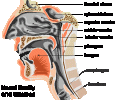Re: Ketogenic Diet - Path To Transformation?
Thanks, i get the idea now. I am not opposed to fat, in fact my fat intake over that last 7 mouths has increased a lot. I just had some fatty bacon with saucisse, and find that it's filling, satisfying, and i don't seem to have any side effects from the consumption of it.
Also over the last 7 mouths, soup has been the main staple here. The better i got making it (experimenting, trying different types of fatty meats, bones, and different types green vegetables), i started to reduce the vegetables, and increase the fat content of each recipe.
There would be times that after a days hiking in the hills, that for the evening meal i would discard the vegetables, just eat the stock with specks of fat floating on the top, and found it satisfied my appetite, and energy levels through a fat liquid soup diet.
And yes Laura, i did have the brakes on for the longest time about eating fat, having bought into the idea (by the medical programmers) that it was going to be the end of me. But what proved to be the food that was having the most caustic effect on my health, turned out to be gluten, sugar, and carbos.
I don't mean to play stupid, and or wast your time, but it has been a re-education to understanding the benefits of the diets that have been offered here. I am gong-ho to the change, and this new philosophy of how i eat, is what i become, and what should be expected from the efforts. :D
Laura said:Ailén said:c.a. said:Ok, i see what you are saying. It is not like i am trying to starve myself, i can say that feeling of hunger just isn't the same haven restricted the carbohydrates. This afternoon aim preparing some more bacon fat, but will include some lean turkey, that i will consume with some butter leaf lettuce.
That's a start, but I don't know why you have to have LEAN turkey. Just forget about all that programming! If meat naturallly has fat, it's meant to be eaten that way. Also, a lot of people seem to have found out that poultry is not the best. Not only are birds fed really bad nowadays, but it's also too lean. So, why don't you just enjoy a fatty steak or a fatty pork chop with that bacon fat?
It really is amazing how thoroughly people's minds have been programmed against fat. I can tell you that if I'm going to eat something, I want it to be as fatty as I can tolerate at that moment. Don't see any point in wasting chewing time and stomach space on anything lean or on veggies that just tear me up.
Thanks, i get the idea now. I am not opposed to fat, in fact my fat intake over that last 7 mouths has increased a lot. I just had some fatty bacon with saucisse, and find that it's filling, satisfying, and i don't seem to have any side effects from the consumption of it.
Also over the last 7 mouths, soup has been the main staple here. The better i got making it (experimenting, trying different types of fatty meats, bones, and different types green vegetables), i started to reduce the vegetables, and increase the fat content of each recipe.
There would be times that after a days hiking in the hills, that for the evening meal i would discard the vegetables, just eat the stock with specks of fat floating on the top, and found it satisfied my appetite, and energy levels through a fat liquid soup diet.
And yes Laura, i did have the brakes on for the longest time about eating fat, having bought into the idea (by the medical programmers) that it was going to be the end of me. But what proved to be the food that was having the most caustic effect on my health, turned out to be gluten, sugar, and carbos.
I don't mean to play stupid, and or wast your time, but it has been a re-education to understanding the benefits of the diets that have been offered here. I am gong-ho to the change, and this new philosophy of how i eat, is what i become, and what should be expected from the efforts. :D



